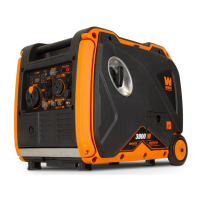MAINTENANCE
Refer to Recommended Maintenance Schedule in Fig. 21 for maintaining the spark plug.
The spark plug is important for proper engine operation. Check the spark plug regularly to maintain proper
engine operation. A good spark plug should be intact, free of deposits, and properly gapped.
SPARK PLUG MAINTENANCE
To inspect or replace the spark plug:
1. Using a Phillips-head screwdriver (not included), unscrew the
top two screws (Fig. 23 - 1) and remove the service panel on the
opposite side of the recoil starter.
2. Gently pull on the spark plug boot (Fig. 27) to remove it. Be
careful not to tear any insulation or wire.
3. Use the included spark plug wrench to unscrew and then care-
fully remove the spark plug from the engine (Fig. 28). TIP: There
is limited space for the wrench to turn. Use both rows of holes in
the spark plug wrench to gain leverage to loosen the plug.
4. Visually inspect the spark plug. If it is cracked or chipped, or if
the electrodes are worn or burned, discard it and replace with a
new spark plug.
We recommend replacing with a NGK BPR6ES/Torch F6RTC
spark plug (part no. 56310i-0104), available for purchase at
wenproducts.com.
5. If re-using the spark plug, use a wire brush to clean any dirt
from around the spark plug base, then re-gap the spark plug.
6. Measure the plug gap with a spark plug gap gauge. The gap
should be 0.7 - 0.8 mm (0.028 - 0.031 in) (Fig. 29). Carefully
adjust the gap if necessary.
7. Screw the spark plug back into the spark plug hole using the
spark plug wrench. Do not over-tighten spark plug. Recommended
tightening of spark plug is ½ to ¾ of a turn (15 ft-lb torque/20.33
Nm) after spark plug gasket contacts spark plug hole.
8. Reinstall the spark plug boot, spark plug rubber cover, and ser-
vice panel.
Fig. 27
Plug Wrench
Spark Plug Boot
Spark Plug
Boot
Cylinder
Assembly
Fig. 28
Fig. 29
0.7 - 0.8 mm
28

